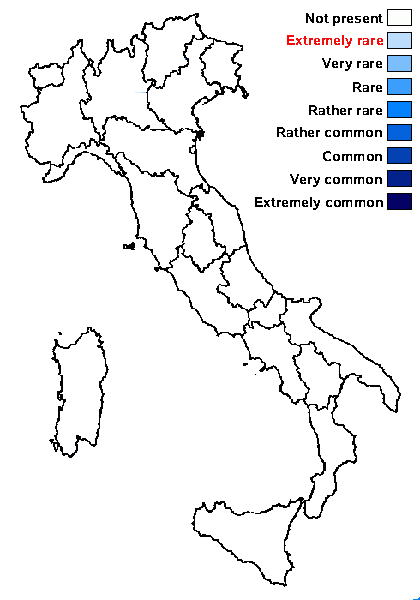Aspicilia flavoreagens (Asta & Cl. Roux) Cl. Roux
in Roux & Coll., Catalogue des lichens et champignons lichénicoles de France métropolitaine. 3e éd., 1: 1285, 2020.. Basionym: Aspicilia candida var. flavoreagens Asta & Cl. Roux - Bull. Mus. Hist. Nat. Marseille, 37: 76, 1977.
Synonyms:
Distribution:
Description: Thallus crustose, episubstratic, up to 0.7 mm thick, continuous to slightly rimose-areolate, more or less pruinose, chalky white, cream-white or pale bluish-grey, forming orbicular patches to 15(-20) cm in diam., often delimited by a black prothallus. Areoles flat to convex, the marginal ones often elongated and more or less radiating. Cortex 50-60 µm thick, filled with crystals; medulla white, I-; algal layer not extending below the hypothecium. Apothecia lecanorine-aspicilioid, round, 0.2-0.8 mm across, at first immersed in the thallus and more or less crateriform, then slightly protruding, with a concave to flat, black but often grey-pruinose disc, and a 0.15-0.3 mm thick, prominent, farinose-pruinose thalline margin. Epithecium brownish green, N+ emerald green; hymenium colourless, 70-85 µm high, I+ reddish brown; paraphyses coherent, submoniliform, the apical cells to 3 µm wide; hypothecium colourless to pale yellowish brown, 35-45 µm high, I+ blue. Asci 8-spored, clavate, the thin outer coat K/I+ blue, the wall and apical dome K/I-. Ascospores 1-celled, hyaline, broadly ellipsoid, 13-25 x 9-18 µm, thin-walled. Photobiont chlorococcoid. Pycnidia black, immersed. Conidia curved, 14-22 x c. 1 µm. Spot tests: thallus K+ yellow or rarely K-, C-, KC-, P-; apothecial margin K+ yellowish brown. Chemistry: stictic acid as the major compound, usually abundant also in thallus.Note: on inclined surfaces of more or less calciferous rocks in dry-warm situations, from the upper montane to the alpine belt. Formerly considered as a chemical strain of A. candida; known from a few stations in the French Alps, but probably more widespread in the Southern Alps; to be looked for in Italy.
Growth form: Crustose
Substrata: rocks
Photobiont: green algae other than Trentepohlia
Reproductive strategy: mainly sexual

Predictive model
Growth form: Crustose
Substrata: rocks
Photobiont: green algae other than Trentepohlia
Reproductive strategy: mainly sexual

Predictive model
 INDEX FUNGORUM
INDEX FUNGORUM
 GBIF
GBIF

